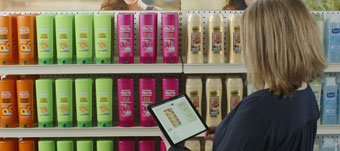After participating in One Door’s Big Ideas Session at NRF this past January, I walked off stage thinking about all of the technology (heat maps, display engagement stats, traffic counters etc.) that retailers are using to plan in-store merchandising, but I recognized a gap in the process. Retailers aren’t using technology to help today’s retail associates execute planograms.
At One Door, we talk about putting the “visual” back in visual merchandising. This means guiding store associates by showing them how they set their stores, instead of telling them what to do, like traditional task management software. To be successful in today’s retail environment, merchandising plans must be executed flawlessly on every shelf, every time – it’s critical to the success of a store. And to do that, you need technology that drives consistent retail merchandising plans and in-store execution across HQ and stores by putting all the right information into the palms of your team’s hands.
Let’s look at some common problems with in-store execution that can be solved with mobile, visually-driven technology.
Fitting a Square Peg in a Round Hole
We know from data that over half of all retailers still use paper planograms and that 48% of planograms don’t match fixtures. Sometimes inventory on a planogram is out of stock or POP materials are missing or damaged. Other times, stores have undergone renovations and receive planograms designed from the old floorplan. When store associates have inaccurate planograms for the physical space in front of them, it can be like fitting a square peg in a round hole – merchandising execution goes off the rails and store associates create their own solution which probably doesn’t align with HQ’s strategy.
The antidote to the merchandising mayhem is a digital platform that delivers planograms for in-store execution in real-time from HQ to stores. If a product is out-of-stock, or a fixture doesn’t match up, the associate can report it instantly. Plus, a digital catalogue of floorplans with localized fixture inventories means that each planogram is localized to a store’s specifications, ensuring that valuable real estate like end caps and front-of-store displays are set consistently to HQ’s strategy.
Planograms for All – No Matter Your Skill Level
With today’s historically low unemployment rates, staffing stores isn’t as easy as it used to be. Hiring associates who are highly skilled in visual merchandising is even tougher. Some employees might have a degree in visual merchandising; others may not. A new associate with no background in visual merchandising may be setting a fixture their very first day on the job. With such a wide disparity of skillsets in the field, and resources spread thin, you can’t leave it up to associates to make merchandising decisions if you want stores to be merchandising according to plan.
So, how do you get your workforce up to speed on merchandising execution without an extensive training program? Give them visually intuitive planograms that are localized for their stores. Guide stores through the placement of POP and SKUs based on what’s in each store today. Give them an app that lets them alert HQ when graphics arrive damaged and allow them to upload photos instantly to show compliance. Finally, put this guided experience in the palm of their hands on a hand-held device.
Show, Don’t Tell
When I talk to store associates, a common problem I hear is that they don’t have all of the information they need to set a display or, conversely, that planograms are overly wordy and confusing. To see how both of these can be true, consider what happens when an employee goes to set a display in the consumer electronics section that requires wiring. Without any instructions, she’s certainly not being enabled to succeed. With instructions, she’s given two pages of written instructions to wire the device. As someone who’s grown up on YouTube and smart phones, this is less than ideal. Imagine if she could watch a video on the same screen as the planogram that shows her how to set up the wiring. That’s a visual capability that would make her job more efficient and more effective.
You can do all the planning in the world to make sure your stores are visually enticing, but those plans are only as good as the person executing them. Are you using technology in a way that drives your in-store visual merchandising forward? Or are you putting it all on paper and handing it to the store to execute?
To continue the conversation in the coming months, we’ll be talking to seasoned visual merchandisers and space planners about the biggest issues they encounter in the field today and the role technology plays in the future of merchandising and space planning.
Scott Heyer is the Product Marketing Manager for One Door. He has worked for some great brands in the Boston market in visual merchandising from Bose Corporation to Staples. Most recently, he was the Director of Visual Merchandising for The Paper Store.

